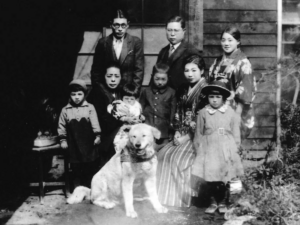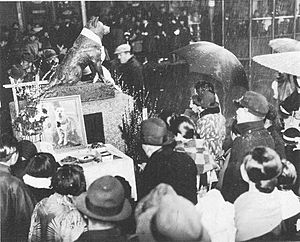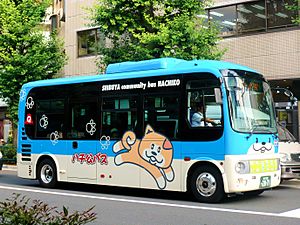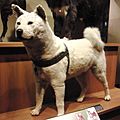Hachikō facts for kids
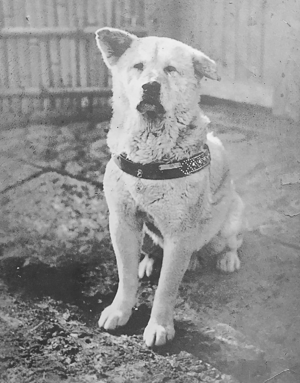
Hachikō (c. 1934)
|
|
| Species | Dog (Canis familiaris) |
|---|---|
| Breed | Akita Inu |
| Sex | Male |
| Born | November 10, 1923 near the city of Ōdate, Akita Prefecture, Japan |
| Died | March 8, 1935 (aged 11) Shibuya, Tokyo, Japan |
| Resting place | Aoyama Cemetery, Minato, Tokyo |
| Known for | Faithfully waiting for the return of his deceased owner for more than nine years until his death. |
| Title | Chūken Hachikō (忠犬ハチ公, 'faithful dog Hachikō') |
| Owner | Hidesaburō Ueno |
| Weight | 41 kg (90 lb) |
| Height | 64 cm (25 in) |
| Appearance | White (peach white) |
| Awards |
|
Hachikō (ハチ公, November 10, 1923 – March 8, 1935) was a Japanese Akita dog remembered for his remarkable loyalty to his owner, Hidesaburō Ueno, for whom he continued to wait for over nine years following Ueno's death.
Hachikō was born on November 10, 1923, at a farm near the city of Ōdate, Akita Prefecture. In 1924, Hidesaburō Ueno, a professor at the Tokyo Imperial University, brought him to live in Shibuya, Tokyo, as his pet. Hachikō would meet Ueno at Shibuya Station every day after his commute home. This continued until May 21, 1925, when Ueno died of a cerebral hemorrhage while at work. From then until his death on March 8, 1935, Hachikō would return to Shibuya Station every day to await Ueno's return.
During his lifetime, the dog was held up in Japanese culture as an example of loyalty and fidelity. Since his death, he continues to be remembered worldwide in popular culture with statues, movies and books. Hachikō is known in Japanese as chūken Hachikō (忠犬ハチ公, "faithful dog Hachikō"), hachi meaning "eight" and the suffix -kō originating as one once used for ancient Chinese dukes; thus, Hachikō could be roughly translated as either "Mr. Eight" or "Sir Eight".
Contents
Life
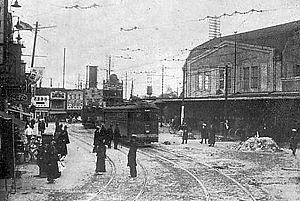
Hachikō, a white Akita, was born on November 10, 1923, at a farm located in Ōdate, Akita Prefecture, Japan. In 1924, Hidesaburō Ueno, a professor in the agriculture department at the Tokyo Imperial University, took Hachikō as a pet and brought him to live in Shibuya, Tokyo. Ueno would commute daily to work, and Hachikō would leave the house to greet him at the end of each day at the nearby Shibuya Station. The pair continued the daily routine until May 21, 1925, when Ueno did not return. The professor had suffered a cerebral hemorrhage while he was giving a lecture to his class, and died without ever returning to the train station at which Hachikō waited.
Each day, for the next nine years, nine months and fifteen days, Hachikō awaited Ueno's return, appearing precisely when the train was due at the station.
Hachikō attracted the attention of other commuters. Many of the people who frequented the Shibuya train station had seen Hachikō and Professor Ueno together each day. Initial reactions from the people, especially from those working at the station, were not necessarily friendly. However, after the first appearance of the article about him in Asahi Shimbun on October 4, 1932, people started to bring Hachikō treats and food to nourish him during his wait.
Publication
One of Ueno's students, Hirokichi Saito, who developed expertise on the Akita breed, saw the dog at the station and followed him to the home of Ueno's former gardener, Kozaburo Kobayashi, where he learned the history of Hachikō's life. Shortly after the meeting, the former student published a documented census of Akitas in Japan. His research found only 30 purebred Akitas remaining, including Hachikō from Shibuya Station.
He returned frequently to visit Hachikō, and over the years he published several articles about the dog's remarkable loyalty. In 1932, one of his articles, published in Asahi Shimbun, placed the dog in the national spotlight.
Hachikō became a national sensation. His faithfulness to his master's memory impressed the people of Japan as a spirit of family loyalty to which all should strive to achieve. Teachers and parents used Hachikō's vigil as an example for children to follow. Teru Ando rendered a sculpture of the dog, and throughout the country, a new awareness of the Akita breed grew.
Eventually, Hachikō's faithfulness became a national symbol of loyalty, particularly to the person and institution of Emperors.
Death
Hachikō died on March 8, 1935, at the age of 11. He was found on a street in Shibuya. In March 2011, scientists finally settled the cause of death of Hachikō: the dog had both terminal cancer and a filaria infection. There were also four yakitori skewers in Hachikō's stomach, but the skewers did not damage his stomach nor cause his death.
Legacy
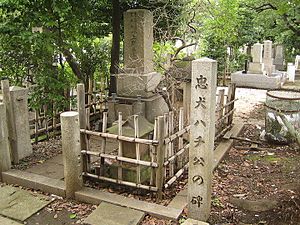
After his death, Hachikō's remains were cremated and his ashes were buried in Aoyama Cemetery, Minato, Tokyo where they rest beside those of Hachikō's beloved master, Professor Ueno. Hachikō's pelt was preserved after his death, and his taxidermy mount is on permanent display at the National Science Museum of Japan in Ueno, Tokyo.
Bronze statues
In April 1934, a bronze statue based in his likeness sculpted by Teru Ando was erected at Shibuya Station. The statue was recycled for the war effort during World War II. In 1948, Takeshi Ando (son of the original artist) made a second statue. The new statue, which was erected in August 1948, still stands and is a popular meeting spot. The station entrance near this statue is named "Hachikō-guchi", meaning "The Hachikō Entrance/Exit", and is one of Shibuya Station's five exits.
A similar statue stands in Hachikō's hometown, in front of Ōdate Station, it was built in 1932. In 2004, a new statue of Hachikō was erected in front of the Akita Dog Museum in Ōdate.
After the release of the American movie Hachi: A Dog's Tale (2009), which was filmed in Woonsocket, Rhode Island, the Japanese Consulate in the United States helped the Blackstone Valley Tourism Council and the city of Woonsocket to unveil an identical statue of Hachikō at the Woonsocket Depot Square, which was the location of the "Bedridge" train station featured in the movie.
On March 9, 2015, the Faculty of Agriculture of the University of Tokyo unveiled a bronze statue depicting Ueno returning to meet Hachikō at the University of Tokyo, Japan to commemorate the 80th anniversary of Hachikō's death. The statue was sculpted by Tsutomu Ueda from Nagoya and depicts a very excited Hachikō jumping up to greet his master at the end of a workday. Ueno is dressed in a hat, suit, and trench coat, with his briefcase placed on the ground. Hachikō wears a studded harness as seen in his last photos.
Annual ceremony
Each year on March 8, Hachikō's devotion is honored with a solemn ceremony of remembrance at Shibuya Station. Hundreds of dog lovers often turn out to honor his memory and loyalty.
Hachikō's bark
In 1994, Nippon Cultural Broadcasting in Japan was able to lift a recording of Hachikō barking from an old record that had been broken into several pieces. A huge advertising campaign ensued and on Saturday, May 28, 1994, 59 years after his death, millions of radio listeners tuned in to hear Hachikō's bark.
Shibuya ward minibus
In 2003, in Shibuya ward, a minibus (officially called "community bus") started routes in the ward, nicknamed "Hachiko-bus". There are four different routes. People can hear the theme song Hachiko-basu no uta (ハチ公バスのうた) in this bus.
=Images for kids
In July 2012, rare photos from Hachikō's life were shown at the Shibuya Folk and Literary Shirane Memorial Museum in Shibuya ward as part of the Shin Shuzo Shiryoten (exhibition of newly stored materials).
In November 2015, a previously undiscovered photograph of Hachikō was published for the first time. The image, which was captured in 1934 by a Tokyo bank employee, shows the dog relaxing by himself in front of Shibuya Station.
Yaeko Sakano
Yaeko Sakano (坂野 八重子, Sakano Yaeko), more often referred as Yaeko Ueno, was the unmarried partner of Hidesaburō Ueno for about 10 years until his death in 1925. Hachikō was reported to have shown great happiness and affection towards her whenever she came to visit him. Yaeko died on April 30, 1961, at the age of 76 and was buried at a temple in Taitō, further away from Ueno's grave, despite her requests to her family members to be buried with her late partner.
In 2013, Yaeko's record, which indicated that she had wanted to be buried with Ueno, was found by Sho Shiozawa, the professor of the University of Tokyo. Shiozawa was also the president of the Japanese Society of Irrigation, Drainage and Rural Engineering, which manages Ueno's grave at Aoyama Cemetery.
Later on November 10, 2013, which also marked the 90th anniversary of the birth of Hachikō, Sho Shiozawa and Keita Matsui, a curator of the Shibuya Folk and Literary Shirane Memorial Museum, felt the need of Yaeko to be buried together with Ueno and Hachikō.
The process began with willing consent from the Ueno and Sakano families and the successful negotiations with management of the Aoyama Cemetery. However, due to regulations and bureaucracy, the process took about 2 years. Shiozawa also went on as one of the organizers involved with the erection of bronze statue of Hachikō and Ueno which was unveiled on the grounds of the University of Tokyo on March 9, 2015 to commemorate the 80th anniversary of Hachikō's death.
Reunion of Hachikō's family
On May 19, 2016, during the ceremony at the Aoyama Cemetery with both Ueno and Sakano families in present, some of the ashes of Yaeko Sakano were buried with Ueno and Hachikō, her name and the date of her death was inscribed on the side of his tombstone, thus fulfilling the reunion of Hachikō's family.
"By putting the names of both on their grave, we can show future generations the fact that Hachikō had two keepers," Shiozawa said. "To Hachikō the professor was his father, and Yaeko was his mother," Matsui added.
Gallery
Similar cases
See also
 In Spanish: Hachikō para niños
In Spanish: Hachikō para niños
- Balto
- Fido (dog)
- Greyfriars Bobby
- List of individual dogs
- Kostya
- "Man's best friend"
- Nipro Hachiko Dome
- Pet ownership in Japan
- Stargazing Dog, a manga about an exceptionally loyal pet.
- Togo (dog)


